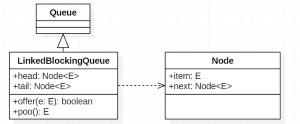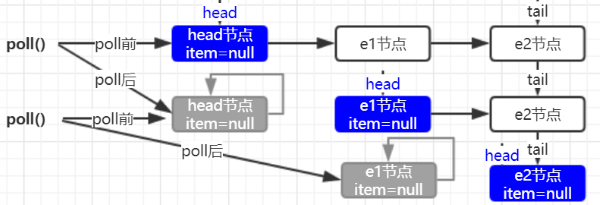JUC源码分析-集合篇(六)LinkedBlockingQueue
JUC源码分析-集合篇(六)LinkedBlockingQueue
1. 数据结构

LinkedBlockingQueue 和 ConcurrentLinkedQueue 一样都是由 head 节点和 last 节点组成,每个节点(Node)由节点元素(item)和指向下一个节点(next)的引用组成,节点与节点之间就是通过这个 next 关联起来,从而组成一张链表结构的队列。默认情况下 head 节点存储的元素为空,last 节点等于 head 节点。和 ConcurrentLinkedQueue 不同的是 LinkedBlockingQueue 是基于 ReentrantLock 锁实现的,因此 head、last 以及 Node.item、Node.next 都不用 volatile 修辞。
// head.item == null
transient Node<E> head;
// last.next == null
private transient Node<E> last;
private static class Node<E> {
E item;
Node<E> next;
}
默认情况下 head、last 都是空节点。
public LinkedBlockingQueue() {
this(Integer.MAX_VALUE);
}
public LinkedBlockingQueue(int capacity) {
if (capacity <= 0) throw new IllegalArgumentException();
this.capacity = capacity;
last = head = new Node<E>(null);
}
2. 基于 ReentrantLock 的实现
private final ReentrantLock takeLock = new ReentrantLock();
// 集合已空则调用notEmpty.await,等集合添加元素后调用notEmpty.singal
private final Condition notEmpty = takeLock.newCondition();
private final ReentrantLock putLock = new ReentrantLock();
// 集合已满则调用notFull.await,等集合取出元素后调用notFull.singal
private final Condition notFull = putLock.newCondition();
3. 入队 offer

和 ConcurrentLinkedQueue 不同,last 是实时指向尾节点的,也就是每次插入元素时都会更新尾节点。代码如下
// offer 非阻塞
public boolean offer(E e) {
if (e == null) throw new NullPointerException();
final AtomicInteger count = this.count;
if (count.get() == capacity)
return false;
// 1. c表示插入前元素的个数
int c = -1;
Node<E> node = new Node<E>(e);
final ReentrantLock putLock = this.putLock;
putLock.lock();
try {
// 2. 元素入队有2个操作:一是元素添加到last.next并更新last;
// 二是唤醒阻塞的put操作继续添加元素(只有put时会阻塞notFull.await)
if (count.get() < capacity) {
// 2.1 元素入队
enqueue(node);
// 2.2 c表示插入前元素的个数
c = count.getAndIncrement();
// 2.3 集合未满,唤醒put操作,继续添加元素
if (c + 1 < capacity)
notFull.signal();
}
} finally {
putLock.unlock();
}
// 3. 插入前集合为空,则唤醒take操作,可以取元素了
if (c == 0)
signalNotEmpty();
return c >= 0;
}
元素入队 enqueue 有两个操作:一是 last.next 节点指向 node;二是 last 指向新的尾节点 node。也就是说 last 一定是指向尾节点的。
private void enqueue(Node<E> node) {
// assert putLock.isHeldByCurrentThread();
// assert last.next == null;
last = last.next = node;
}
4. 出队 poll

// poll 非阻塞
public E poll() {
final AtomicInteger count = this.count;
if (count.get() == 0)
return null;
E x = null;
// 1. poll操作前元素的个数
int c = -1;
final ReentrantLock takeLock = this.takeLock;
takeLock.lock();
try {
// 2. 元素出队有2个操作:一是head.next出队
// 二是唤醒阻塞的take操作继续取出元素(只有take时会阻塞notEmpty.await)
if (count.get() > 0) {
// 2.1 head.next出队
x = dequeue();
// 2.2 c为poll前元素的个数
c = count.getAndDecrement();
// 2.3 集合中元素不为空,唤醒take操作,断续取元素
if (c > 1)
notEmpty.signal();
}
} finally {
takeLock.unlock();
}
// 3. 取元素前集合已满,则唤醒put操作,可以继续添加元素
if (c == capacity)
signalNotFull();
return x;
}
元素出队 dequeue 有三个操作:一是 head.next 出队;二是 head.next 指向自己,等待 GC 回收;三是修改 head 节点。
private E dequeue() {
// assert takeLock.isHeldByCurrentThread();
// assert head.item == null;
Node<E> h = head;
Node<E> first = h.next;
h.next = h; // help GC
head = first;
E x = first.item;
first.item = null;
return x;
}
5. 删除元素 remove
// 删除指定 value 的元素
public boolean remove(Object o) {
if (o == null) return false;
fullyLock();
try {
for (Node<E> trail = head, p = trail.next;
p != null;
trail = p, p = p.next) {
if (o.equals(p.item)) {
// 删除指定节点 p,其中 trail 为 p 的前驱节点
unlink(p, trail);
return true;
}
}
return false;
} finally {
fullyUnlock();
}
}
// 删除指定节点 p,其中 trail 为 p 的前驱节点
// 注意 p.next 没变
void unlink(Node<E> p, Node<E> trail) {
// assert isFullyLocked();
// p.next is not changed, to allow iterators that are
// traversing p to maintain their weak-consistency guarantee.
p.item = null;
trail.next = p.next;
if (last == p)
last = trail;
if (count.getAndDecrement() == capacity)
notFull.signal();
}
5. 将集合中的元素取出 drainTo
// 将集合中的全部元素取出到集合 c 中
public int drainTo(Collection<? super E> c) {
return drainTo(c, Integer.MAX_VALUE);
}
// 将集合中的 maxElements 个元素取出到集合 c 中
public int drainTo(Collection<? super E> c, int maxElements) {
if (c == null)
throw new NullPointerException();
if (c == this)
throw new IllegalArgumentException();
if (maxElements <= 0)
return 0;
boolean signalNotFull = false;
final ReentrantLock takeLock = this.takeLock;
takeLock.lock();
try {
int n = Math.min(maxElements, count.get());
// count.get provides visibility to first n Nodes
Node<E> h = head;
int i = 0;
try {
while (i < n) {
Node<E> p = h.next;
c.add(p.item);
p.item = null;
h.next = h;
h = p;
++i;
}
return n;
} finally {
if (i > 0) {
// assert h.item == null;
head = h;
signalNotFull = (count.getAndAdd(-i) == capacity);
}
}
} finally {
takeLock.unlock();
if (signalNotFull)
signalNotFull();
}
}
每天用心记录一点点。内容也许不重要,但习惯很重要!
JUC源码分析-集合篇(六)LinkedBlockingQueue的更多相关文章
- JUC源码分析-集合篇(十)LinkedTransferQueue
JUC源码分析-集合篇(十)LinkedTransferQueue LinkedTransferQueue(LTQ) 相比 BlockingQueue 更进一步,生产者会一直阻塞直到所添加到队列的元素 ...
- JUC源码分析-集合篇:并发类容器介绍
JUC源码分析-集合篇:并发类容器介绍 同步类容器是 线程安全 的,如 Vector.HashTable 等容器的同步功能都是由 Collections.synchronizedMap 等工厂方法去创 ...
- JUC源码分析-集合篇(七)PriorityBlockingQueue
JUC源码分析-集合篇(七)PriorityBlockingQueue PriorityBlockingQueue 是带优先级的无界阻塞队列,每次出队都返回优先级最高的元素,是二叉树最小堆的实现. P ...
- JUC源码分析-集合篇(三)ConcurrentLinkedQueue
JUC源码分析-集合篇(三)ConcurrentLinkedQueue 在并发编程中,有时候需要使用线程安全的队列.如果要实现一个线程安全的队列有两种方式:一种是使用阻塞算法,另一种是使用非阻塞算法. ...
- JUC源码分析-集合篇(九)SynchronousQueue
JUC源码分析-集合篇(九)SynchronousQueue SynchronousQueue 是一个同步阻塞队列,它的每个插入操作都要等待其他线程相应的移除操作,反之亦然.SynchronousQu ...
- JUC源码分析-集合篇(八)DelayQueue
JUC源码分析-集合篇(八)DelayQueue DelayQueue 是一个支持延时获取元素的无界阻塞队列.队列使用 PriorityQueue 来实现. 队列中的元素必须实现 Delayed 接口 ...
- JUC源码分析-集合篇(四)CopyOnWriteArrayList
JUC源码分析-集合篇(四)CopyOnWriteArrayList Copy-On-Write 简称 COW,是一种用于程序设计中的优化策略.其基本思路是,从一开始大家都在共享同一个内容,当某个人想 ...
- JUC源码分析-集合篇(一)ConcurrentHashMap
JUC源码分析-集合篇(一)ConcurrentHashMap 1. 概述 <HashMap 源码详细分析(JDK1.8)>:https://segmentfault.com/a/1190 ...
- JUC源码分析-线程池篇(三)ScheduledThreadPoolExecutor
JUC源码分析-线程池篇(三)ScheduledThreadPoolExecutor ScheduledThreadPoolExecutor 继承自 ThreadPoolExecutor.它主要用来在 ...
随机推荐
- Dubbo入门到精通学习笔记(十九):MySQL源码编译安装、MySQL主从复制的配置
文章目录 MySQL 源码编译安装(CentOS-6.6+MySQL-5.6) 一.服务器配置: 二.源码安装 MySQL5.6.26: MySQL主从复制的配置 环境 依赖课程 MySQL 主从复制 ...
- ZJUT11 多校赛补题记录
牛客第一场 (通过)Integration (https://ac.nowcoder.com/acm/contest/881/B) (未补)Euclidean Distance (https://ac ...
- 【Java多线程系列七】ExecutorService
java.util.concurrent.ExecutorService接口提供了许多线程管理的方法 Method 说明 shutdown 拒绝接收新的任务,待已提交的任务执行后关闭,且宿主线程不阻塞 ...
- Cococs2d-x学习路线
| 版权声明:本文为博主原创文章,未经博主允许不得转载. Cocos2D-X推荐书: Cocos2d-x权威指南
- Linux NIO 系列(04-3) epoll
目录 一.why epoll 1.1 select 模型的缺点 1.2 epoll 模型优点 二.epoll API 2.1 epoll_create 2.2 epoll_ctl 2.3 epoll_ ...
- Gym 102007I 二分 网络流
题意:给你一张图,每个城市有一些人,有不超过10个城市有避难所,避难所有容量上限,问最快多久可以让所有人进入避难所? 思路:二分时间,对于每个时间跑一遍最大流,判断最大流是不是人数即可.我们还需要用二 ...
- JavaScript 绑定事件时传递数据
var data = { name: 'Ruchee', email: 'my@ruchee.com' }; data.handleEvent = function (e) { console.log ...
- GetWindowsDirectoryA and GetSystemDirectory
#include <iostream> #include <Windows.h> using std::cout; using std::endl; // 获取Windows文 ...
- linux开放指定端口命令
方式一 CentOS: 1.开启防火墙 systemctl start firewalld 2.开放指定端口 firewall-cmd --zone=public --add-p ...
- 了解跨站请求伪造CSRF
参考以下两篇文章: https://www.cnblogs.com/Erik_Xu/p/5481441.html https://www.cnblogs.com/4littleProgrammer/p ...
